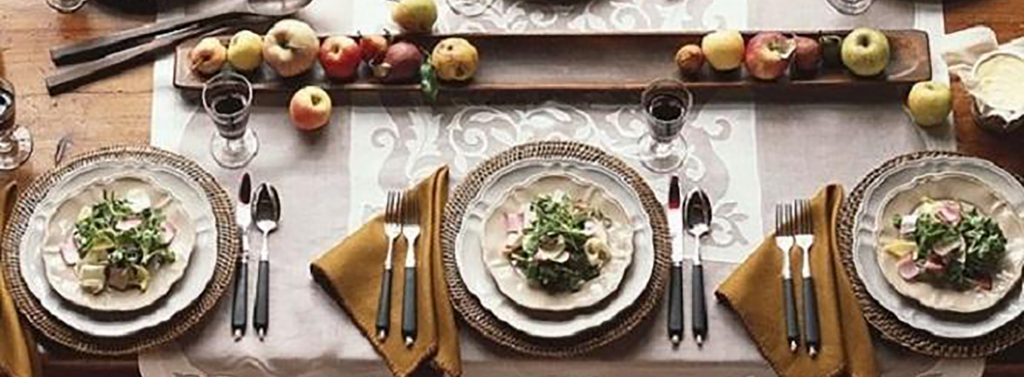What is the difference between dinner and lunch? Not much really. A healthy woman should see both dinner and lunch as equivalent. I don’t think it really matters whether you have dinner at lunch time, supper at night or are inviting friends to a formal dinner party. In every case the evening meal should contain roughly the same number of calories (about 500) just as we ate for breakfast and for lunch. But to me dinner conjures up a more refined meal. It is certainly a good idea to enjoy at least one meal each day at a table, with friends or family. That celebration could include a glass of wine and two or three courses, followed by coffee. I often wonder why I’m tempted to introduce ‘extras’ when I entertain. The last thing I want to do is damage my friends’ health. There isn’t any reason to see any meal as a reason to pig out, but dinner can be an occasion to bring out the fine porcelain, polish the glassware and spread the crisp linens. It is an occasion to buy more expensive foods that you might not always afford, such as smoked salmon, an exotic salad or a tropical fruit. Remember the days when pineapples were considered chic? Perhaps they should be again. Elegant sufficiency is my watchword for a lovely dinner, whether it is an occasion or a simple TV supper.
Those of you who are used to tucking into a large meal at night, preceded by nibbles and cocktails, washed down with a bottle of wine and rounded-off with something gooey, will be dismayed by the prospect of a more subdued meal at night. But let me try to persuade you.
I understand that at the end of the day many of us are exhausted, we have neither the energy not the inclination to start cooking. We’ve probably rushed round the supermarket picking a few things from the shelves, all designed to reduce cooking to a minimum. We get home tired and hungry and the first thing many of us do is to open a bottle of wine and sit down with a salty snack.
For most of my weight loss clients it is dinner that seems to undo good intentions. That may be because they haven’t actually eaten enough earlier in the day. Many studies show that it is under-eating earlier in the day that causes dinner disasters. If you eat a good breakfast, a protein-icious lunch and take a break in order to enjoy two or three snacks in between time, you are less likely to binge at night [1]. Snacks are the subject of next week’s article, but suffice it to say here that you can and should snack – just don’t overdo it and choose healthy options.
If you starve yourself during the day, when you are busy and expending energy, then your body will try to make up for your oversight in the evening, when you are more sedentary and thus less likely to use-up all those calories before you go to bed. I think this is the origin of the myth that we shouldn’t eat any carbs after 6.00pm. Of course, we should eat balanced meals throughout the day. However, if we eat too little in the morning and compensate by over-eating in the evening the consequences are likely to be obesity and insomnia. The antidote to evening bingeing is daylight eating! But just for the avoidance of doubt;
“You can and should include healthy wholemeal carbs in your evening meal.”
“You are more likely to feel like preparing and enjoying a healthy evening meal if you have eaten about 2/3rds of your calories and nutrients earlier in the day.”
As we age it becomes more and more important to eat regular meals. Women who have experienced the menopause will find their metabolism will have changed rather dramatically and rather quickly. The kindest way of treating metabolic shifts is to ensure that we eat regularly and healthily. At the age of 35 you could probably go all day without lunch, at 45 that becomes a far less sensible approach, and at 55 it verges on the foolish. Many of the symptoms of menopause in particular, and ageing in general, can be alleviated by a healthy diet eaten at regular intervals and never to excess. Hot flushes, sweating, heart palpitations, insomnia, irritability, mood swings, weight gain, constipation, dry and flaky skin and hair fragility all have some basis in poor or infrequent nutrition [2].
Regain the night
If you try to starve yourself at night, to make up for the day’s excesses, you’ll most likely simply run out of energy and feel sleepy. If you over-eat at night, or eat the wrong things, the results are similar, you’ll nod off while watching telly. If you use alcohol as a relaxant you are also very likely to fall asleep quickly, but suffer from insomnia later in the night. A nutritional meal, eaten a few hours before bed time might actually bring evenings back to you. Instead of snoozing, evenings are a great time for more creative pursuits. Eat well at night, so that you can enjoy your evenings.
Check the day’s record
Dinner, or supper or high tea, whatever you like to call it, should be an opportunity to re-balance the day’s eating. Take a look at your chart of portions. Look at the foods you haven’t eaten enough of and try to design a meal that redresses the balance.
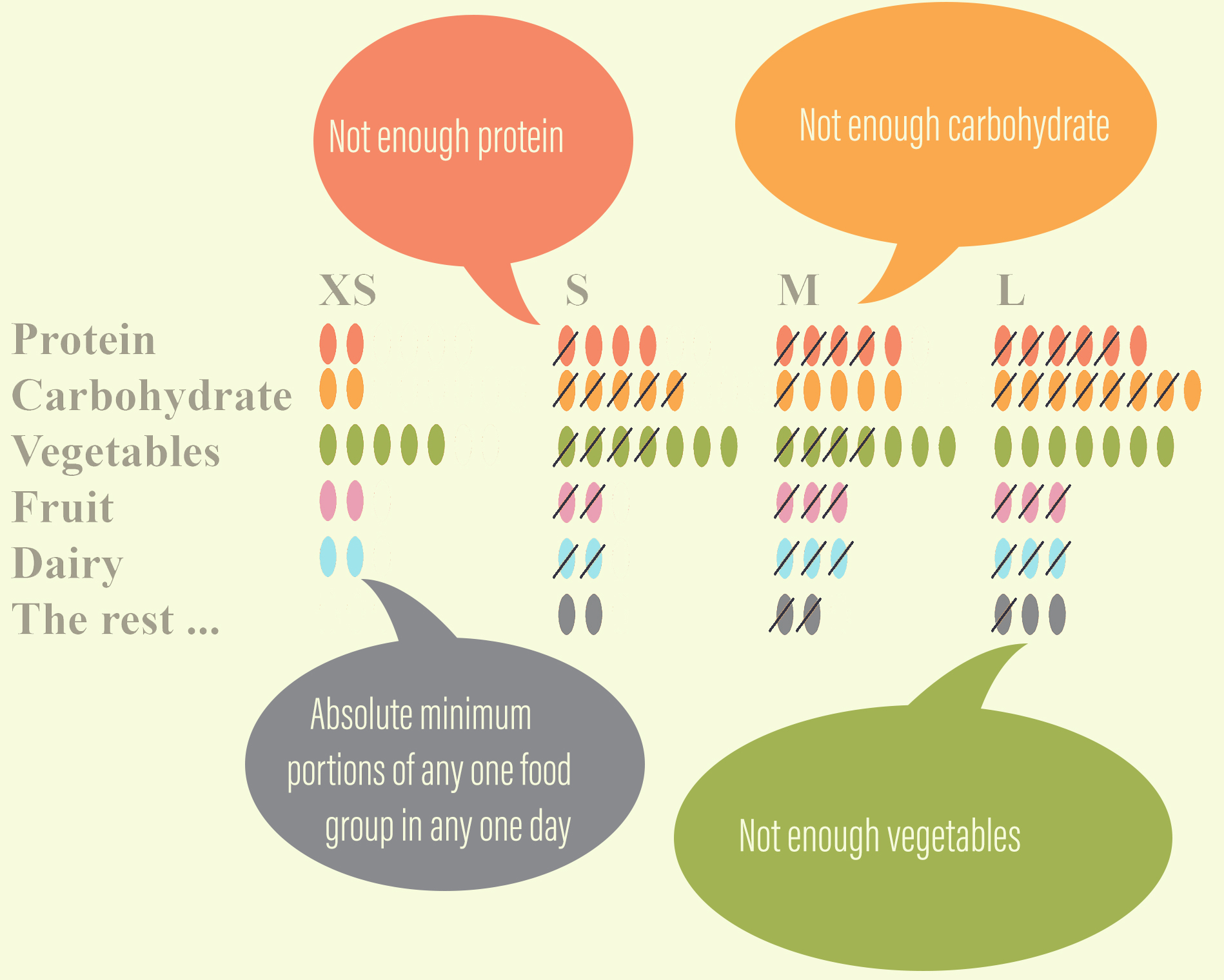
Not enough protein
While many nutritionists don’t speak much about protein, assuming that we all eat quite enough, women over 50 need to start monitoring their protein intake a little more carefully. Not little and often, but much and often, should be your new watchwords, even if you’ve decided to go on a diet. Fortunately, protein is often the easiest food to cook, and in these days of refrigeration, it isn’t difficult to store. Next time you are at the supermarket, stock up on a few protein foods that will keep. For example, frozen white fish, smoked fish, eggs, tofu and Quorn products all keep for a long time in the fridge or freezer. Legumes, another good source of protein, come dried anyway, so will keep for ages. Frozen fish is always useful because fillets can be baked in the oven, without defrosting, in less than twenty minutes. This recipe provides high octane nutrition, in 25 minutes.
Recipe: Honey and orange baked fish
White fish and lentils make a very tasty combination that can be cooked all in one pot. Unlike white fish, lentils also contain a high quantity of iron. Combine with foods rich in vitamin C such as orange and parsley which make this plant-based type of non-heme iron easier to absorb.
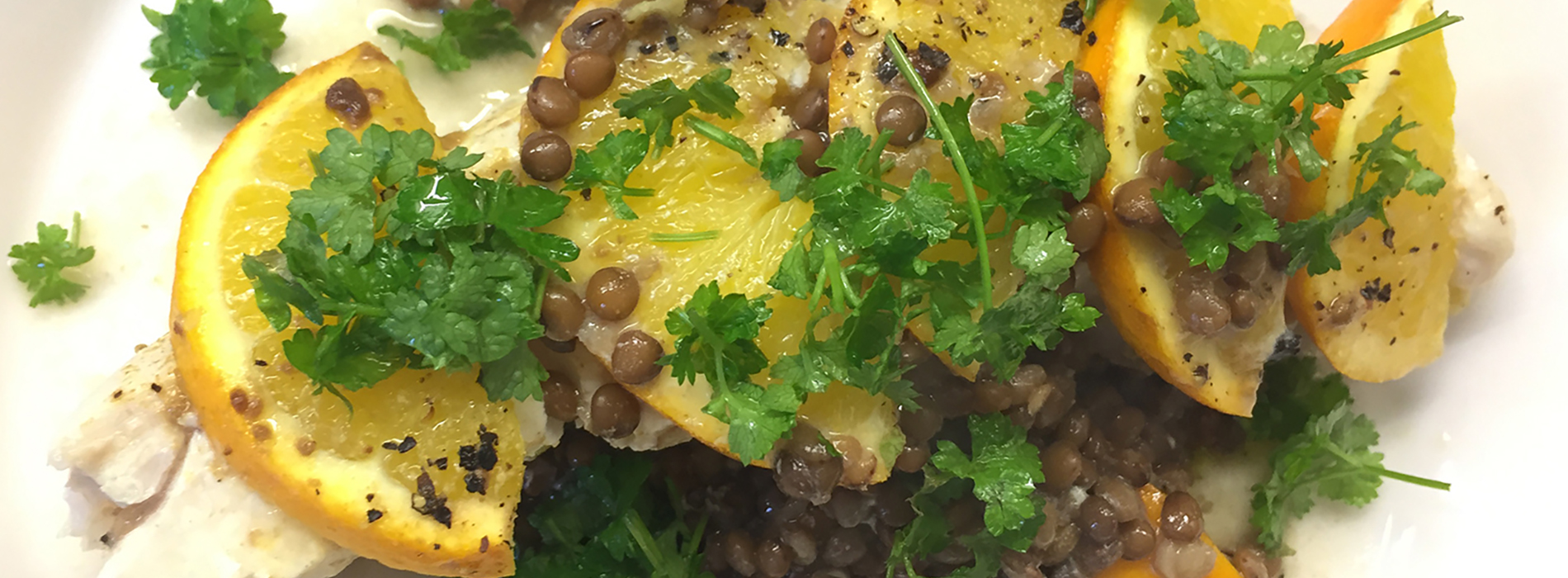
Ingredients for 2
- 240g pack frozen white fish
- Whole orange washed and sliced – with its skin intact (190g)
- 2 tsp clear honey 7g
- 2 tsp wholegrain mustard 10g
- 1 tbsp olive oil 13.5g
- 50ml apple cider vinegar, stock or water
- 250g pouch or half a tin of ready-to-eat lentils
- Fresh parsley for garnish 50g
Nutrition
Each portion counts as 3 portions protein, 1/2 fruit and 1/2 the rest
or
386 calories, 37g protein, 90mg vitamin C
You could treat the parsley as a portion of vegetables if you like.
Method
Preheat a conventional oven to 200°C*. Drain the lentils and place them in the base of an oven-proof casserole dish (with a lid). Place the frozen fish on top and cover with thin slices of orange. Drizzle with the other ingredients except the parsley, season and replace the lid. Cook in the centre of the oven for 20-25 minutes, until the flesh is opaque all the way through and the stock is steaming. Sprinkle generously with chopped parsley at the table. Prepare a salad or vegetables while the dish is being cooked. The lentils take the place of potatoes or rice.
This one dish will make up for low protein intake during the day. Each portion counts as two portions of fish protein and one portion of plant protein. This is based on a Waitrose packet of essential frozen pollock. Once opened it is better to cook the whole packet of fish and reserve extra portions for later in the week. Once cooled down, the casserole with lid will keep the cooked food fresh for a few days in a refrigerator.
Tip *
You may cook this dish in a fan oven at 180°C without preheating, but the fan will tend to waft fishy aromas all around the kitchen. Switching to conventional cooking keeps the kitchen sweeter.
Not enough wholemeal carbohydrate
Some books will tell you that you don’t actually need much carbohydrate at all. And it is true that the body can make do with a small amount of sugar, converting fat into extra energy, if required to do so. But sugars are not the point of eating carbohydrate. The body needs all the other nutrients and the fibre that come built-into the plant-based carbohydrate (mainly cellulose) structure. Remember refined carbohydrate, such as white bread or pasta, should be counted in with ‘the rest’. I’m talking wholegrain here!
Wholemeal wheat is particularly nutritious, containing significant quantities of protein, iron and calcium as well as an unbelievably rich mix of micro-nutrients, far wider than the list of minerals and vitamins we are used to seeing [i]. In fact, 46 different natural ingredients in wholemeal flour are thought to contribute to the prevention of cardio-pulmonary diseases, cancers, metabolic diseases, gut, skeletal and brain disease, reduce neurodegenerative disease and increase antioxidant activity. Many of these ingredients do not exist at all in refined flour, many others are depleted [3].
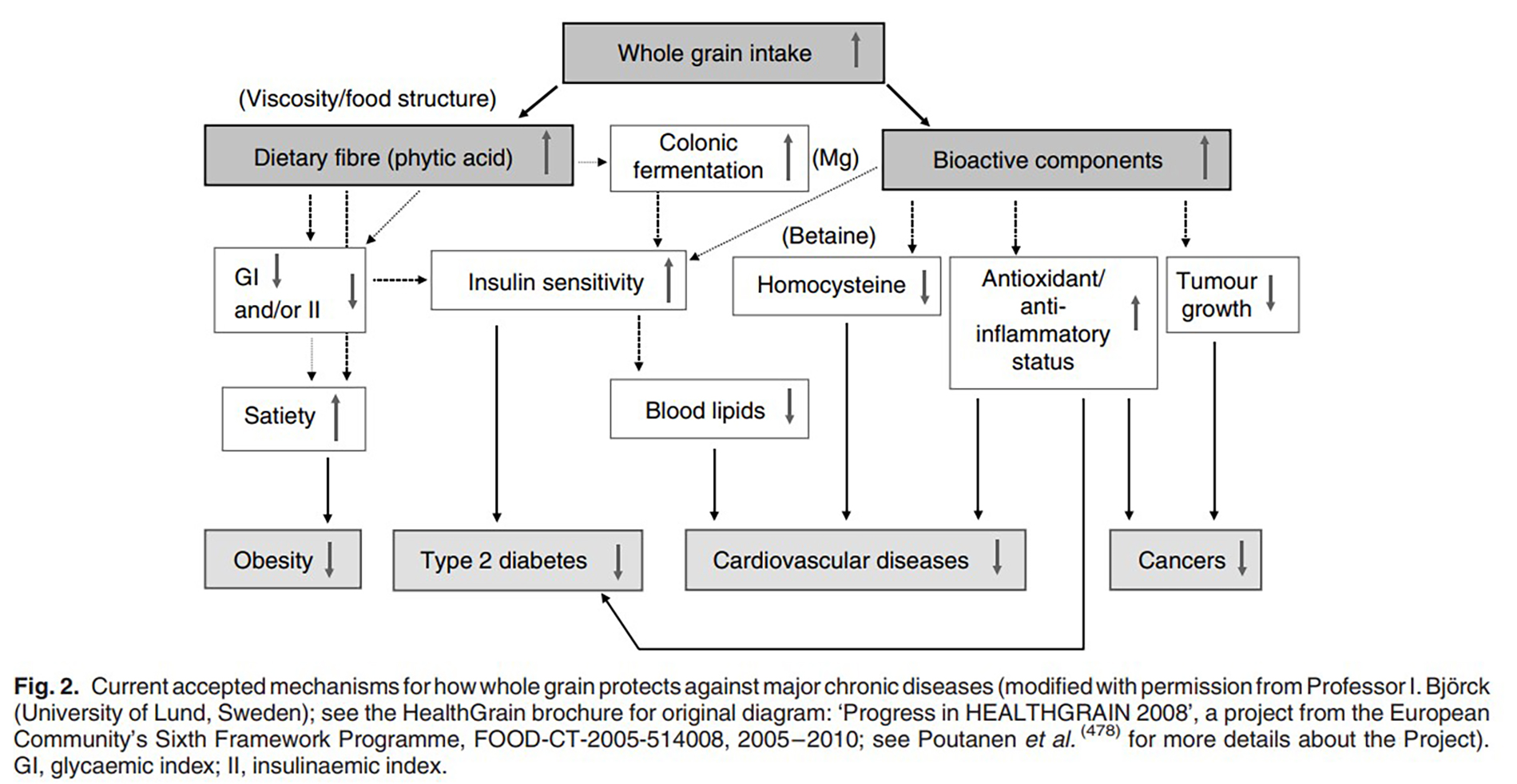
If you are low on carbohydrates by the end of the day, simply reach for a slice or two of wholemeal bread. Eat the bread unbuttered, with the meal, as the basis for a sandwich supper, or simply with a thin layer of butter and home-made jam. But do try and ensure that you are selecting wholegrain or wholemeal based products. There really isn’t a nutritional contest between refined and wholegrain, as the table below illustrates:
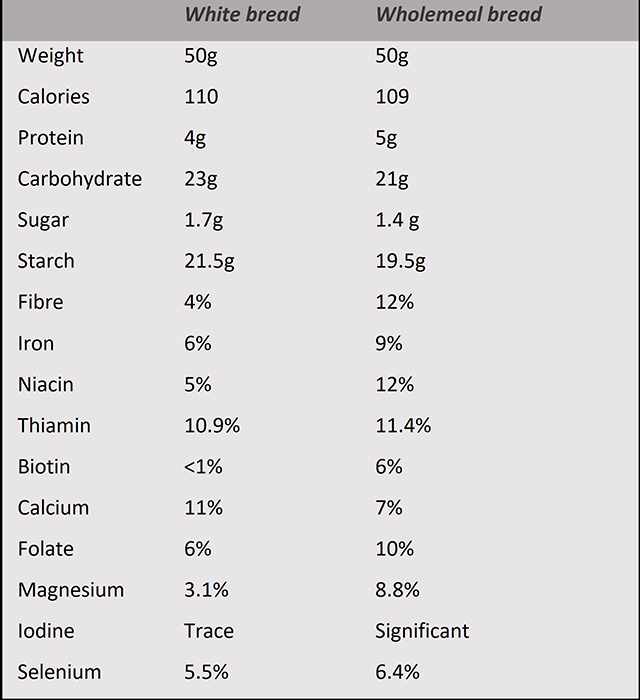
Because of the poor nutritional profile of white refined flour, it is fortified by law with added calcium carbonate (chalk), thiamin hydrochloride, niacin and iron. It should be noted that the fortification does not bring refined flour anywhere near the same nutritional quality of wholemeal flour, except in the case of calcium, where the chalk content exceeds the natural calcium present in wholemeal flour. The figures above take account of the fortification of refined flour, however many other important bioactive components and none of the fibrous content are added back.
Not enough vegetables
If you’ve been reading this blog closely, you will already be aware that current research suggests we should all be eating five to seven portions of vegetables each day, not the paltry five portions of fruit and veg that the UK government considers adequate [4]. At first the suggestion of consuming 300g (5 portions) of vegetables every single day may seem quite difficult to achieve. It is very common to find you’ve been all day and hardly eaten anything vegetable. However, it is an omission that is extremely easy to redress. Simply eat a large salad alongside whatever else you may be cooking in the evening.
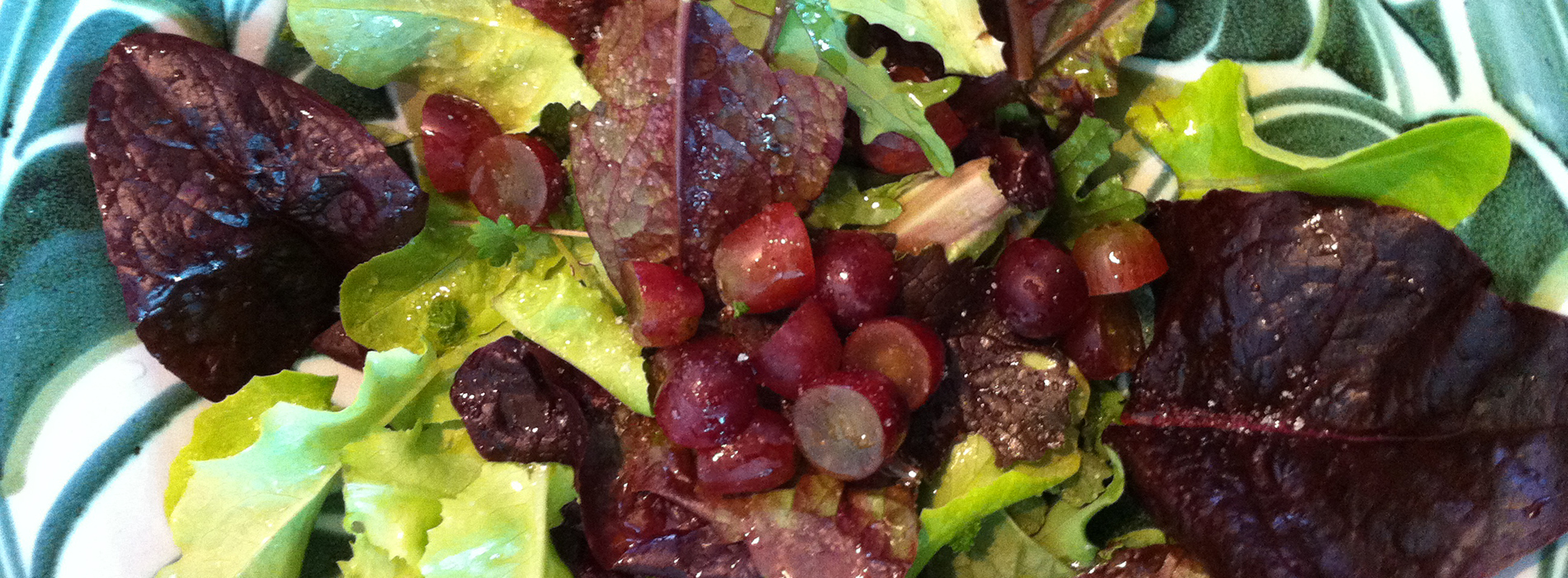
In France a salad is often served as a separate course. I like this idea; it gives vegetables due importance in a meal. But in order to be able to eat a salad in the evening, you will need to have fresh salad available to you. Washed and prepared lettuces or mixed leaves will keep for several days in the chiller. Buy the freshest you can find, simply wash the leaves, dry in a lettuce shaker and store in a large self-seal plastic bag. Alongside salad leaves serve tomatoes, cucumbers, celery, green vegetables, calabrese, root vegetables and fruit if you like. These will all keep just fine in a larder or a cool vegetable drawer.
If you are in a café or restaurant ask for a green salad or a mixed salad even if there isn’t one on the menu. Most cafes will oblige. Get used to making and eating big salads and your body will respond very positively.
Not enough fruit
A traditional supper ends with a piece of fruit. Keep fresh fruit in the home as a ready-made dessert. If eating out in the evening, beware high energy (high calorie) desserts. Keep a banana or an orange in your bag for occasions when there is nothing desirable on the menu. Ask for a plate and a knife and fork to eat it with – just to make the point!

Keep a good stock of tree fruit like apples and pears as well as citrus in the home. They all last well. But splash out on the occasional treat – a whole pineapple, fresh figs and depending on the season, berries of all types are my favourite. These days it is possible to buy blueberries and strawberries all year round. But beware of the distance imports. As well as being tasteless and old by the time they reach our shores, the air miles they have travelled make them unsustainable. Use your discernment to choose fresh, local and seasonal as your mainstay and interrogate the country of origin, the growing conditions and the transportation system that brings the banana or the pineapple to your door. Choose the best quality you can afford – your body will thank you.
Not enough dairy
Dairy is rarely lacking from my evening meal. A small portion of cheese is one of my evening treats. But remember that cheese can contain high quantities of fat, it is very easy to over-do the cheese.
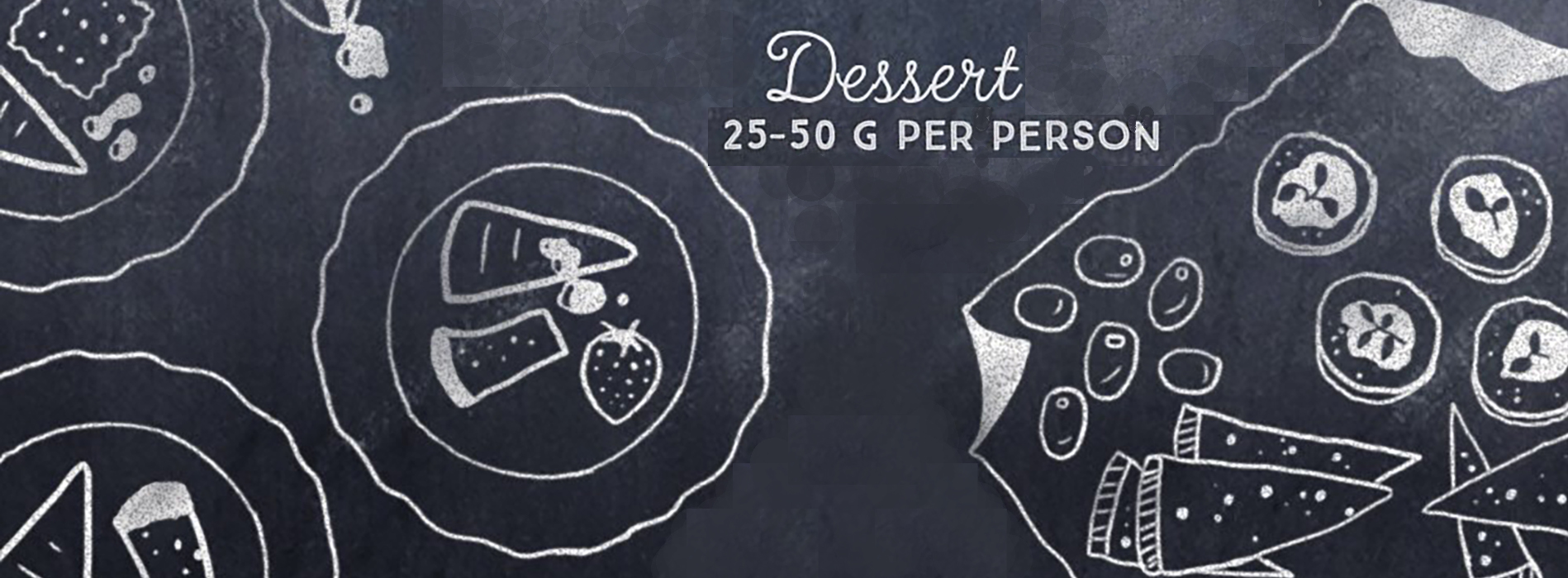
For dessert, 20-50g is an adequate portion. Hard cheese, as a general rule, is fattier and thus higher in calories, than soft cheese. I use this handy guide to gauge the quantity of cheese in a 100 calorie portion – one dot.
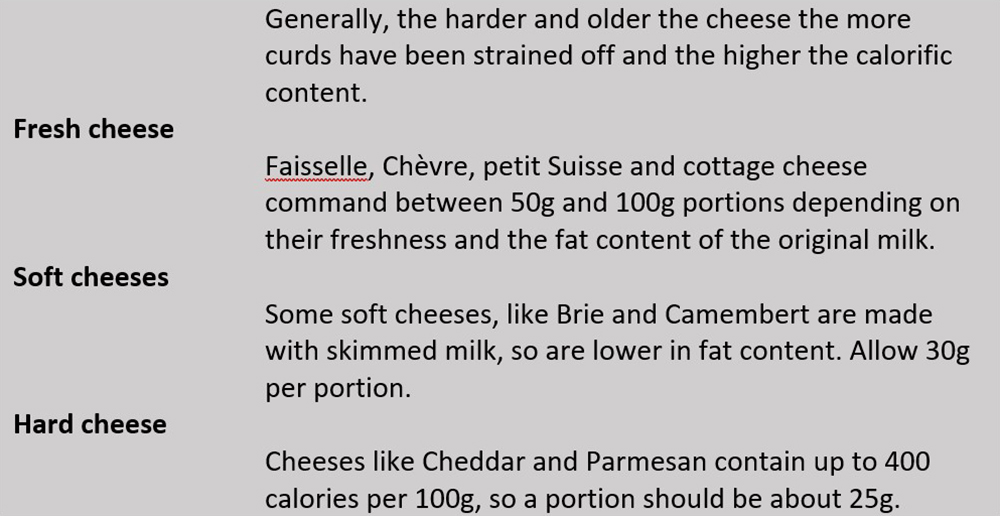
At the end of the day a hot milky drink is a very soothing beverage. Try 200ml hot milk, with 1 heaped teaspoon of pure coco powder and half a teaspoonful of brown sugar.
What if I’ve over-eaten during the day – and all the wrong things.
Don’t beat yourself up. Don’t starve yourself now – it won’t work. Go for a walk if you can. If you’ve eaten badly during the day, the likelihood is that you might not yet have reached your requirement for protein, fruit or veg. So, eat a light meal at night, focussing on whatever wholesome foods have been lacking.
We all have days like this. Remember ‘tomorrow is another day’.
Not enough of ‘The Rest’
Don’t worry if you haven’t eaten anything of the rest. That means you’ve eaten all wholegrain, no processed or packet foods and mainly home-made. Good for you. Good for your body!
PROGRAMME
20 December – Commensality (celebrations, parties and eating with friends)
27 December – The New You
[1]Sjöholm, M. Sahlgrenska Akademin. Does eating frequency correlate with overweight and obesity among Swedeish men and women? Research thesis in Clinical Nutrition. ie this is not a peer reviewed publication, but published by the university. It refers to several papers that are not accessible, but behind a paywall, thus quite a useful overview from a respected university.
[2] Stachowiak, G., Pertyński, T. & Pertyńska-Marczewska, M. Metabolic disorders in menopause. Prz. Menopauzalny 14, 59–64 (2015).
[3] Fardet, A. New hypotheses for the health-protective mechanisms of whole-grain cereals: what is beyond fibre? doi:10.1017/S0954422410000041
[4] Aune, D. et al. Fruit and vegetable intake and the risk of cardiovascular disease, total cancer and all-cause mortality-A systematic review and dose-response meta-analysis of prospective studies. Int. J. Epidemiol. (2017). doi:10.1093/ije/dyw319
Notes
[i] Bioactive ingredients of wholemeal wheat flour. Alkylresorcinols, p-Aminobenzoic acid, Avenanthramides, Betaine, Calcium, b-Carotene, Choline, Copper, b-Cryptoxanthin, Cystine, Flavonoids, Folate, Fructans, Glutathione – reduced, Inositols, Insoluble fibre, Iron, Lignans, a-Linolenic acid, Lutein, Magnesium, Manganese, Melatonin, Methionine, Nicotinic Acid, Oligosaccharides, g-Oryzanol, Pantothenic acid, Phenolic acids, Phosphorus, Phylloquinone, Phytic acid, Phytosterols, Policosanol, Potassium, Pyridoxine, Resistant starch, Riboflavin, Saponins, Selenium, Sodium, Soluble fibre, Thiamin, Tocopherols, Tocotrienols and Zeaxanthin.
